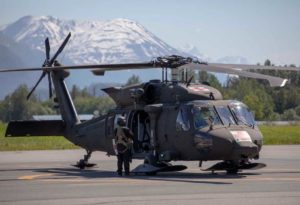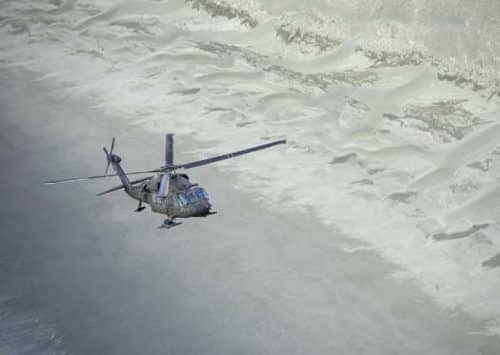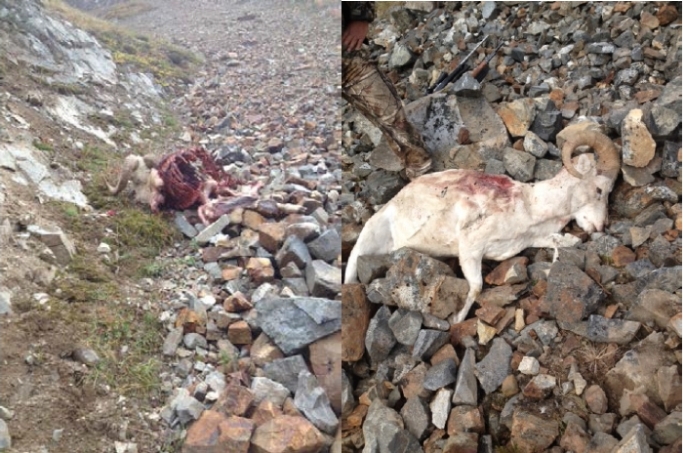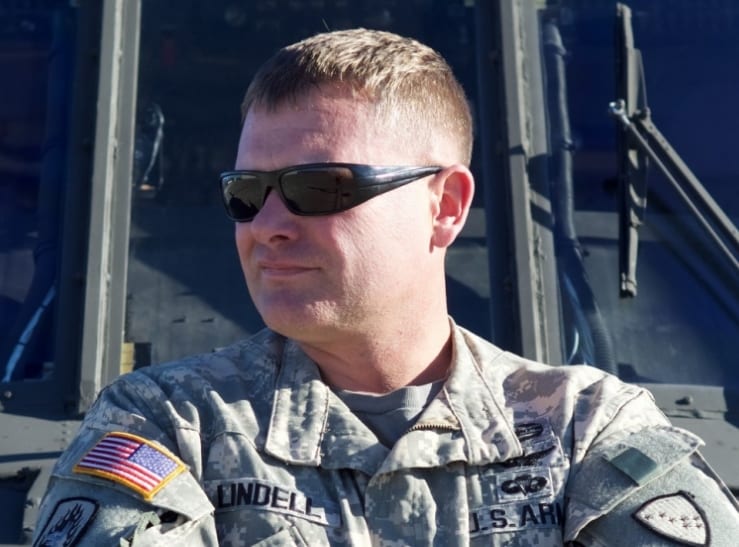
JOINT BASE ELMENDORF-RICHARDSON, Alaska — Four members of the Alaska Army National Guard’s Golf Company, Detachment 1, 2-211th General Support Aviation Battalion, 207th Aviation Regiment, received the 2021 Rescue of the Year award from DUSTOFF Association in early February for their efforts in a rescue last fall.
At approximately 1:30 p.m. Sept. 15, 2021, a sheep hunter activated his InReach satellite communication device to send an SOS signal to the Alaska State Troopers. He was suffering minor cold weather injuries and malnourishment near Cottonwood Creek, 40 miles northeast of Anchorage, down the Knik River Valley.
The hunter was stranded at an elevation of 5,750 feet for two days on a three-by-three-foot ledge that was on a 50-degree slope when it started snowing and made it impossible to descend.
Once the AST received the distress signal, they immediately requested assistance from the Guard through the Alaska Rescue Coordination Center. The AKRCC sent the request to the 207th AVN, where Capt. Cody McKinney accepted the mission as the pilot in command and prepared to launch a hoist-capable HH-60M Black Hawk helicopter with medevac crew.
“When we got this call, the [cloud] ceilings were forecasted below the hunter, and we knew that it was a technical rescue if we could even get to him,” said McKinney, who is also deputy state army aviation officer and commander of G-Co., 2-211th GSAB. “We thought ‘what type of medevac unit are we if we don’t try?’ so we decided to launch knowing that we might not be able to get up to him, and we just talked through the mitigating factors.”
McKinney, Chief Warrant Officer 2 Bradley Jorgensen, the mission co-pilot, Staff Sgt. Sonny Cooper, the helicopter crew chief and hoist operator, and Sgt. 1st Class Damion Minchaca, the flight paramedic and hoist rider, departed Bryant Army Airfield on base at approximately 2:30 p.m., just one hour after the hunter sent his SOS.
The team was determined to rescue the hunter, according to McKinney. Weather forecasts predicted that the early-winter snow storm would only get worse, which would leave him stranded for at least another couple of days if the crew didn’t act quickly.[content id=”79272″]

“We saw a small hole [in the clouds] tucked up against the mountains, so we took our opportunity to go up through there,” said McKinney. “Once you get in between two layers like that, there’s a risk that the hole closes up if there’s cloud movement, and there was. At that point, we were fully committed to this guy and to finishing the rescue.”
Once they made it through the base cloud layer, they used a dynamic hoist technique to retrieve the stranded hunter. Unlike a static hoist where the helicopter hovers over the target, the dynamic hoist technique allows for quicker, precise extraction without bringing the aircraft to a prolonged hover.
“We will fly towards the target, open the door, and bring the hoist rider out, all while we’re flying about 60 or 70 knots,” explained McKinney. “Then we approach the target while that hoist rider is also descending.”
The medevac team did this in white-out conditions, with extremely limited visibility.
“It’s basically as if we were inside of a ping pong ball where everything around you is white and you don’t have a good visual reference,” he explained. “And when you’re trying to do a hoist at almost 6,000 feet to a one-foot section, it’s fairly technical because a lot could go wrong.”
Once Minchaca landed on the ledge, he pushed the hunter back against the mountain wall so he couldn’t fall while he secured him in an aviation rescue vest. In just over one minute, the hunter was safe and being hoisted up into the helicopter to be transported to Palmer airport.
“[The mission] was just very technical, which set it apart from some of our other ones,” said McKinney. “Normally, when we go on a mission we know that certain variables are taken care of, and in this case we just didn’t know. We had a low probability of actually being able to get to him, and we went anyways, because that’s what we do.”
The rescue award will be officially presented to the four crew members in San Antonio, Texas, May 21 during the DUSTOFF Association Annual Awards Banquet Ceremony.
The association, established in 1980, is a nonprofit veterans’ organization for enlisted, officers, families, and others who have ever engaged in or supported Army aeromedical evacuation programs.
“It takes a tremendous amount of people involved in a rescue like this,” said McKinney. “The expectation is that we go out and do that, and it’s not possible unless we have trust of leadership, the RCC that’s willing to give us the mission, the Air Guard that cross-trains with us. Even though we’re getting highlighted, it was very much an Alaska National Guard joint operation.”
###[content id=”79272″]







